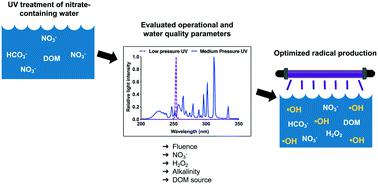当前位置:
X-MOL 学术
›
Environ. Sci.: Water Res. Technol.
›
论文详情
Our official English website, www.x-mol.net, welcomes your
feedback! (Note: you will need to create a separate account there.)
Nitrate with benefits: optimizing radical production during UV water treatment
Environmental Science: Water Research & Technology ( IF 3.5 ) Pub Date : 2020-02-18 , DOI: 10.1039/c9ew01138b Sydney L. Vinge 1, 2, 3, 4, 5 , Samuel W. Shaheen 1, 2, 3, 4, 5 , Charles M. Sharpless 5, 6, 7, 8 , Karl G. Linden 1, 2, 3, 4, 5
Environmental Science: Water Research & Technology ( IF 3.5 ) Pub Date : 2020-02-18 , DOI: 10.1039/c9ew01138b Sydney L. Vinge 1, 2, 3, 4, 5 , Samuel W. Shaheen 1, 2, 3, 4, 5 , Charles M. Sharpless 5, 6, 7, 8 , Karl G. Linden 1, 2, 3, 4, 5
Affiliation

|
Nitrate is ubiquitous in natural and human impacted water systems. Irradiation of nitrate by UV light during water treatment can produce hydroxyl and other radicals (e.g., reactive nitrogen species) that react with and oxidize organic contaminants. The aim of this study was to investigate water quality and operational conditions that impact radical production during medium pressure UV (MPUV, 200–400 nm) and low pressure UV (LPUV, 254 nm) treatment of nitrate-containing waters. Because the behavior of nitrate has been shown to be influenced by its concentration and the presence of hydrogen peroxide and alkalinity during UV photolysis, these parameters were systematically evaluated for their effect on the generation of radicals and formation of nitrite. Bench-scale experiments used para-chlorobenzoic acid to indirectly measure radicals formed in UV/NO3− systems. Analysis using a central composite design revealed a synergistic effect between nitrate and alkalinity. Optimal conditions for radical production during LPUV were found to shift from low to high nitrate concentration as alkalinity was increased. The role of nitrite and its formation in diverse water matrices during UV exposure was assessed at high UV fluence levels (up to 4000 mJ cm−2) that are often used in remediation of contaminated waters. Radical production during MPUV/NO3− became increasingly higher than LPUV/NO3− as the ratio of nitrate to hydrogen peroxide concentration was increased. However, the efficacy of MPUV decreased as fluence was increased (>1000 mJ cm−2) due to formation of nitrite which scavenged hydroxyl radicals.
中文翻译:

硝酸盐的优点:在紫外线水处理过程中优化自由基的产生
硝酸盐在自然和受人类影响的水系统中无处不在。在水处理过程中用紫外线照射硝酸盐会产生与有机污染物发生反应并氧化的羟基和其他自由基(例如,反应性氮物种)。这项研究的目的是研究在中压紫外线(MPUV,200–400 nm)和低压紫外线(LPUV,254 nm)处理含硝酸盐的水期间,影响自由基产生的水质和操作条件。由于已显示硝酸盐的行为受其浓度以及UV光解过程中过氧化氢和碱度的影响,因此系统评估了这些参数对自由基产生和亚硝酸盐形成的影响。实验室规模的实验中使用的对氯苯甲酸来间接测量形成在UV / NO自由基3 -的系统。使用中央复合设计进行的分析表明,硝酸盐和碱度之间具有协同作用。发现随着碱度的增加,在LPUV过程中产生自由基的最佳条件从低硝酸盐浓度转变为高硝酸盐浓度。在高紫外线通量水平(最高4000 mJ cm -2)下评估了亚硝酸盐的作用及其在各种水基质中的形成(通常用于修复受污染的水)。急产MPUV中/ NO 3 -变得比LPUV越来越高/ NO 3 -随着硝酸盐与过氧化氢浓度之比的增加。然而,由于通量的增加(> 1000 mJ cm -2),MPUV的功效下降,这是由于形成了清除羟基自由基的亚硝酸盐。
更新日期:2020-02-18
中文翻译:

硝酸盐的优点:在紫外线水处理过程中优化自由基的产生
硝酸盐在自然和受人类影响的水系统中无处不在。在水处理过程中用紫外线照射硝酸盐会产生与有机污染物发生反应并氧化的羟基和其他自由基(例如,反应性氮物种)。这项研究的目的是研究在中压紫外线(MPUV,200–400 nm)和低压紫外线(LPUV,254 nm)处理含硝酸盐的水期间,影响自由基产生的水质和操作条件。由于已显示硝酸盐的行为受其浓度以及UV光解过程中过氧化氢和碱度的影响,因此系统评估了这些参数对自由基产生和亚硝酸盐形成的影响。实验室规模的实验中使用的对氯苯甲酸来间接测量形成在UV / NO自由基3 -的系统。使用中央复合设计进行的分析表明,硝酸盐和碱度之间具有协同作用。发现随着碱度的增加,在LPUV过程中产生自由基的最佳条件从低硝酸盐浓度转变为高硝酸盐浓度。在高紫外线通量水平(最高4000 mJ cm -2)下评估了亚硝酸盐的作用及其在各种水基质中的形成(通常用于修复受污染的水)。急产MPUV中/ NO 3 -变得比LPUV越来越高/ NO 3 -随着硝酸盐与过氧化氢浓度之比的增加。然而,由于通量的增加(> 1000 mJ cm -2),MPUV的功效下降,这是由于形成了清除羟基自由基的亚硝酸盐。










































 京公网安备 11010802027423号
京公网安备 11010802027423号